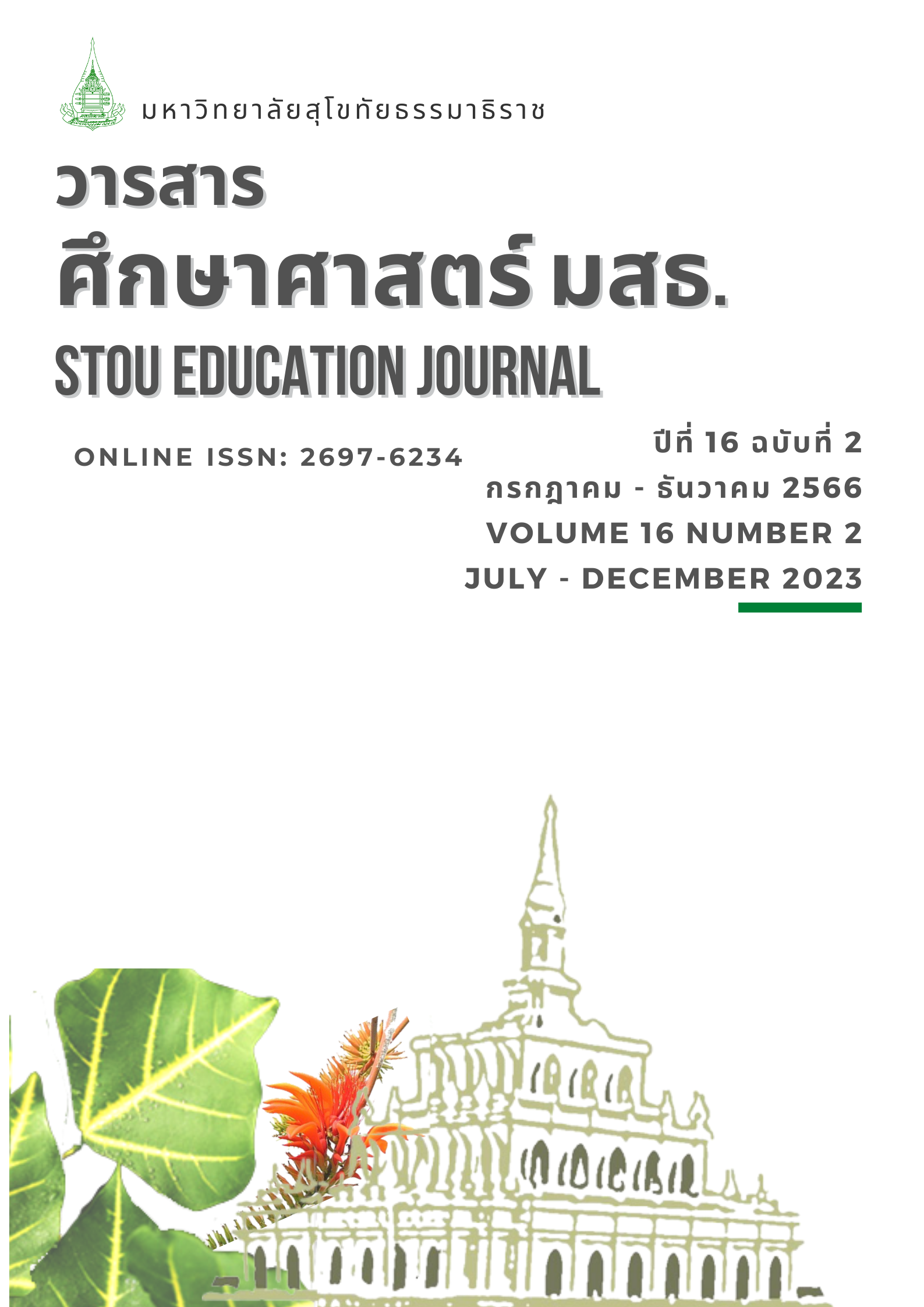The Results of Developing Teachers' Ability to Design Active Learning Activities to Deal with Disasters Using Local Area Networks and Lesson Study: A Case Study of Sai Khao-Tha Ho Subdistrict Administrative Organization School, Chiang Rai Province
Main Article Content
Abstract
This research aimed to study the results of developing teachers' ability to design active learning activities to deal with disasters using local area networks and lesson study. The target group comprised 18 teachers from Sai Khao-Tha Ho Subdistrict Administrative Organization School. Data were collected using training plans, assessment forms for designing active learning activities to deal with disasters, and an interview form. The collected data were analyzed using mean and content analysis. The results indicated that, 1) overall, teachers' ability to design active learning activities to deal with disasters was at a good level. They employed multiple instructional methods and active learning techniques consistent with the learning outcomes and the learners' ages. These methods included (1) using simulations for surviving shooting rampages, evacuating during earthquakes and fires; (2) implementing gamification, such as using a Monopoly game to learn earthquake survival and a Bingo game to address the fight against COVID-19; (3) using music to raise awareness, such as earthquake remembrance songs and songs promoting frequent handwashing; (4) employing role plays to build understanding and sympathy, including practicing self-isolation at home for both COVID-19 patients and co-residents; (5) demonstrating and practicing evading earthquakes and proper mask-wearing; (6) utilizing geographic processes and instruments to create a risk map; and (7) employing the timeline technique to learn the history of earthquakes. 2) Furthermore, the director and teachers demonstrated a shared vision, worked as a team, maintained positive energy, and focused on mutual benefits. This collaborative effort led to success in designing active learning activities to deal with disasters for students and the community.
Article Details
References
กุญชรี ค้าขาย. (2554). รายงานการวิจัยการสร้างเครือข่ายสังคมเพื่อขับเคลื่อนนวัตกรรมการพัฒนาองค์กร การศึกษา: บทเรียนภาคสนามจากโครงการวิจัยและพัฒนานวัตกรรมการเพิ่มประสิทธิภาพขององค์กร ทางการศึกษาด้วยการจัดการความรู้. สำนักงานเลขาธิการสภาการศึกษา.
จักรกฤษณ์ จันทะคุณ. (2558). ภัยพิบัติศึกษา: แนวทางการจัดกิจกรรมการเรียนรู้เพื่อเตรียมความพร้อมรับมือภัยพิบัติ (ตอนที่ 1). วารสารศึกษาศาสตร์ มหาวิทยาลัยนเรศวร, 17(4), 188-201.
จักรกฤษณ์ จันทะคุณ. (2564). การพัฒนาหลักสูตรภัยพิบัติท้องถิ่นแผ่นดินไหว สำหรับโรงเรียนในพื้นที่เสี่ยงภัยแผ่นดินไหว ด้วยการจัดการความรู้. วารสารศึกษาศาสตร์ มหาวิทยาลัยนเรศวร, 23(1), 384-398.
จักรกฤษณ์ จันทะคุณ และ สุพรทิพย์ ธนภัทรโชติวัต. (2564). การพัฒนาเครือข่ายโรงเรียนพัฒนาหลักสูตรภัยพิบัติท้องถิ่นแผ่นดินไหว จังหวัดเชียงราย. วารสารศึกษาศาสตร์ มหาวิทยาลัยนเรศวร, 23(3), 395-410.
จักรกฤษณ์ จันทะคุณ, กษมะ กลิ่นเจริญ, และ อมรรัตน์ วัฒนาธร. (2564). การพัฒนาความสามารถในการเตรียมความพรัอมรับมือแผ่นดินไหว ของนักเรียนโดยใช้กิจกรรมเป็นฐาน: กรณีศึกษาโรงเรียนแม่ลาววิทยาคม จังหวัดเชียงราย. วารสารสังคมศาสตร์และมานุษยวิทยาเชิงพุทธ, 6(12), 122-137.
เจือจันทร์ จงสถิตอยู่ และ อรุณศรี จิตต์แจ้ง. (2556). พลังเครือข่ายในพื้นที่. สำนักงานกองทุนสนับสนุนการวิจัย.
ชาริณี ตรีวรัญญู. (2560). การพัฒนากระบวนการเรียนการสอนเพื่อเสริมสร้างความสามารถในการพัฒนานวัตกรรมการเรียนการสอนของนิสิตครูโดยใช้แนวคิดการพัฒนาบทเรียนร่วมกันเสริมด้วยกระบวนการคิดการปฏิบัติตามปรัชญาของเศรษฐกิจพอเพียง. วารสารครุศาสตร์, 45(2), 21-40.
ทิศนา แขมมณี. (2562). หลักสูตรฐานสมรรถนะกับบทบาทศึกษานิเทศก์แนวใหม่. http://www.watponcmpeo.files.wordpress.com.
ธนา นิลชัยโกวิทย์ และ อดิศร จันทรสุข. (2552). ศิลปะการจัดกระบวนการเรียนรู้เพื่อการเปลี่ยนแปลง: คู่มือกระบวนกรจิตตปัญญา. เอส.พี.เอ็น. การพิมพ์.
ประพนธ์ ผาสุกยืด. (2550). การจัดการความรู้ (KM): ฉบับขับเคลื่อน LO (พิมพ์ครั้งที่ 2). สำนักพิมพ์ใยไหม.
วจี ปัญญาใส. (2562). การสานพลังภาคีเครือข่ายสร้างนวัตกรรมพัฒนาการอ่านออกเขียนได้เพื่อส่งเสริมความรอบรู้ด้านสุขภาวะ.วารสารวิจัยและพัฒนา มหาวิทยาลัยราชภัฏบุรีรัมย์, 14(2), 137-147.
วิจารณ์ พานิช. (2559). ขอบฟ้าใหม่ในการจัดการความรู้. ภาพพิมพ์.
สมบูรณ์ ตันยะ, สิทธิศักดิ์ จุลศิริพงษ์, ประมวล ตันยะ, สิรินาถ จงกลกลาง, ชยพล ธงภักดี และ ลลิตา ธงภักดี. (2559). การพัฒนาเครือข่ายการเรียนรู้ด้านการสอนตามแนวปฏิรูปการศึกษาในสถานศึกษาขั้นพื้นฐาน จังหวัดนครราชสีมา. วารสารมนุษยศาสตร์และสังคมศาสตร์ มหาวิทยาลัยราชภัฏกำแพงเพชร, 22(1), 14-22.
สุพจน์ เจิมสวัสดิพงษ์. (2557). สารจากอธิบดีกรมทรัพยากรธรณี. การประชุมสัมมนา เรื่อง บทเรียนแผ่นดินไหวแม่ลาว เชียงราย ภัยพิบัติใกล้ตัว 20 พฤศจิกายน 2557 ณ โรงแรมเดอะสุโกศล กรุงเทพมหานคร (หน้า ข). สํานักงานกองทุนสนับสนุนการวิจัย.
สุรีรัตน์ อารีรักษ์ สกุลก้องโลก. (2563). การพัฒนาสมรรถนะการจัดการเรียนรู้ของครูคณิตศาสตร์โดยใช้การ พัฒนาบทเรียนร่วมกันในโรงเรียนประถมศึกษาจังหวัดนนทบุรี. วารสารศึกษาศาสตร์ มสธ., 13(1), 175-190.
สิริพันธุ์ สุวรรณมรรคา. (2556). Teachers as Learner: การสร้างชุมชนแห่งการเรียนรู้ทางวิชาชีพครูโดยใช้ กระบวนการชี้แนะและการเป็นพี่เลี้ยง. (วีดิทัศน์). ปิโก (ไทยแลนด์) ร่วมกับคณะครุศาสตร์ จุฬาลงกรณ์มหาวิทยาลัย.
สำนักงานเลขาธิการสภาการศึกษา. (2563). การจัดการเรียนรู้ฐานสมรรถนะเชิงรุก. 21 เซ็นจูรี่.
สำนักเฝ้าระวังแผ่นดินไหว กรมอุตุนิยมวิทยา. (2557). รายงานการเกิดแผ่นดินไหวบริเวณจังหวัดเชียงราย. https://www.seismology.tmd.go.th/.../seismo-doc-140470345.
หฤทัย อนุสสรราชกิจ และ วราลี ถนอมชาติ. (2562). การพัฒนาชุมชนการเรียนรู้ทางวิชาชีพด้วยการพัฒนาบทเรียนร่วมกันเพื่อส่งเสริมสมรรถนะการจัดการเรียนรู้ของครูปฐมวัยในจังหวัดจันทบุรี. วารสารวไลยอลงกรณ์ปริทัศน์ (มนุษยศาสตร์และสังคมศาสตร์), 9(2), 1-11.
อาจอง ชุมสาย ณ อยุธยา. (2556). การบรรยายพิเศษ เรื่อง “ภัยพิบัติโลก… รุนแรงกว่าที่คิด” https://www.file:///C:/Users/asus/Downloads/aridablue,+Journal+manager,+02+Dr.Arjong.pdf
Adiyoso, W., & Kanegae, H. (2013). Effectiveness of disaster-based school program on students’ earthquake-preparedness. Journal of Disaster Research, 8(5), 1009-1017.
Baker-Doyle, K. J. (2021). Transformative teachers: Teacher leadership and learning in a connected world. Harvard Education Press.
Chen, F. (2014). Primary investigation on reform of post practice mode based on school-enterprise collaborative innovation. https://www.atlantis-press.com/proceedings/icetss-14/14672.
Consortium for Disaster Education Indonesia. (2011). A framework of school-based disaster preparedness. http://www.preventionweb.net/.../26013_26008aframeworkofschool.
Dufty, N. (2018). A new approach to disaster education. http://www.researchgate.net/publication/329105392.
Fernandez, C. (2002). Learning from Japanese approaches to professional development: The case of lesson study. Journal of teacher education, 53(5), 393-405.
Hargreaves, D. H. (2003). Education epidemic: Transforming secondary schools through innovation networks.https://www.demos.co.uk/files/educationepidemic.pdf
Roberts, J. (2012). Observational feedback: A valid tool or a recipe for disaster?. Australian Educational Leader, 34(3), 22-25.
Shaw R., Shiwaku, K., & Takeuchi Y. (2011). Disaster education. Emerald Publisher.
Yılmaz, E. (2014). School-based disaster education through curricular and extra-curricular activities: Acomparative case study.
Yusuf, R., Fajri, I., & Gani, S. A. (2022,). Disaster education in disaster-prone schools: A systematic
review. In IOP Conference Series: Earth and Environmental Science, International Conference on Environmental, Energy and Earth Science (pp.1-7). https://doi:10.1088/1755-1315/1041/1/012034


